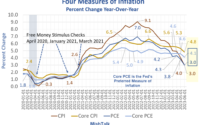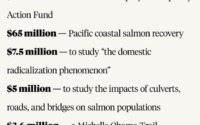Fed’s housing market ‘reset’ has officially set off the second-biggest home price correction of the post-WWII era
In June, Fed Chair Jerome Powell told reporters that the overheated U.S. housing market—which saw U.S. home prices rise over 40% in just over two years—needed a “reset.” And higher mortgage rates, he said, would slowly bring “balance” back to the market.
“We saw [home] prices moving up very very strongly for the last couple of years. So that changes now…I’d say if you are a homebuyer, somebody or a young person looking to buy a home, you need a bit of a reset. We need to get back to a place where supply and demand are back together,” Powell said.
While Powell was unsure what the Fed’s housing “reset” would mean for home prices, Fortune speculated it meant prices would fall. It looks like we were right.
According to the latest Case-Shiller report published on Tuesday, U.S. home prices fell another 0.8% in September. That marks the third consecutive monthly home price decline since Powell’s June statement. Prior to 2022, the seasonality adjusted Case-Shiller National Home Price Index hadn’t published a month-over-month decline since the housing crash bottomed out in 2012.
This latest Case-Shiller report—which found a 2.2% price decline in U.S. homes since June—means we’ve moved into the second biggest home price correction of the post-World War II era. On paper, it’s tied with the 2.2% drop between May 1990 and April 1991, however, given that the index is a three-month average, we know the October numbers will surpass that mark. That said, it’s still far below the 26% peak-to-trough decline that occurred between 2007 and 2012.
How can this 2.2% drop already qualify as the second biggest correction of the post-World War II era? It boils down to the fact that, historically speaking, home prices on a national basis have been fairly sticky. Sellers resist going below market comps unless economics forces their hand.
View this interactive chart on Fortune.com
“I think that the religion people had from 1946 to 2008, that housing prices always go up, is dead. My parents believed that it was literally inconceivable for [home] prices to go down,” Glen Kelman recently told Fortune. The ensuing 2008 housing crash broke that “religion” and taught buyers and sellers alike, he said, that home prices can indeed fall. “So folks respond [now] to that [correction] with almost PTSD, and they pull back much more quickly.”
It isn’t just average Joes who know prices can fall—the 2008 example also made institutional firms and builders more alert. Those firms are a big reason why home prices are falling so fast right now.
“When the shiitake mushrooms hit the fan, you [investors] want to get out first. The way to do that is to figure out where the lowest sale is, and be 2% below that. And if it doesn’t sell in the first weekend, move it down [again],” Kelman recently told Fortune. In his view, real estate investors, including Redfin’s iBuyer business and builders, are helping to drive prices down faster this time around.
Another reason prices might be falling so quickly is simply because home prices rose so high, so fast during the pandemic. And now that mortgage rates have also spiked, many buyers are either priced out or have lost their mortgage eligibility altogether.
View this interactive chart on Fortune.com
When asked in September to clarify his June housing “reset” comment, Powell told reporters the U.S. housing market had entered into a “difficult [housing] correction.” While that housing correction has clearly arrived, it’s hardly even across the country.
Among the 20 major U.S. housing markets tracked by Case-Shiller, the home price decline ranges from just -0.55% in Atlanta to -10.4% in San Francisco. (Chicago and Cleveland remain at their peak 2022 price).
It isn’t just San Francisco: The Western half of the country, including markets like Seattle (down 9.16%) and Phoenix (down 3.86%), is clearly the epicenter of the ongoing home price correction. What’s going on? The Western half of the country, where affordability is a greater issue, has heightened vulnerability to interest rate shocks. In markets like San Francisco and Seattle, monetary tightening means their high-powered tech job centers are pulling back just as tech stocks plunge. Meanwhile, higher mortgage rates pushed frothy boomtowns markets like Phoenix over the top.
The correction continues to be milder in the Northeast and Midwest. Markets like New York and Detroit are only down 1.58% and 0.81% from their respective peaks. As of the housing cycle rolled over this summer, those markets were not flooded with inventory from iBuyers and builders. That has given sellers in markets like New York and Detroit a bit more breathing room.
View this interactive chart on Fortune.com
It’s true that we’re in a housing correction. It’s also true that homeowners at-large are still doing quite well. In fact, “well” might be an understatement.
So far, the housing correction’s 2.2% dip in prices between June and September has only taken a minor bite out of the pandemic housing boom’s massive 41.29% run-up in prices. Since March 2020, home prices are still up 38.33%.
Not only have homeowners been shielded from rent shocks, many also benefited by refinancing to 2% or 3% mortgage rates during the pandemic.
View this interactive chart on Fortune.com
Where do we head from here? It depends on who you ask.
Economists at Zillow believe the home price correction will wrap up by January 2023, and we’ll see a 0.8% gain in home values over the coming 12 months. Meanwhile, economists at Morgan Stanley, Goldman Sachs, and Moody’s Analytics think home prices will fall around 10% from peak-to-trough. While firms like Zonda and KPMG think we’re barreling towards a 15% peak-to-trough decline in U.S. home prices.
Of course, when Zillow or Moody’s says “U.S. home prices” they’re talking about a national aggregate. Whatever comes next will surely vary by market.
Want to stay updated on the housing correction? Follow me on Twitter at @NewsLambert.
This story was originally featured on Fortune.com
More from Fortune:
The American middle class is at the end of an era
Sam Bankman-Fried’s crypto empire ‘was run by a gang of kids in the Bahamas’ who all dated each other
The 5 most common mistakes lottery winners make
Sick with a new Omicron variant? Be prepared for this symptom
[ad_2]
Source link


